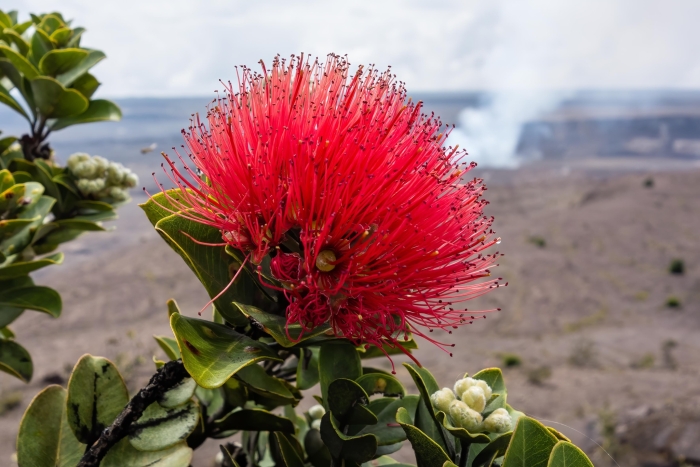ʻōhi’A Lehua
(Metrosideros polymorpha)
ʻōhi’A Lehua (Metrosideros polymorpha)
/
/

© Dan Harville
CC BY-SA 4.0
Image By:
© Dan Harville
Recorded By:
Copyright:
CC BY-SA 4.0
Copyright Notice:
Photo by: © Dan Harville | License Type: CC BY-SA 4.0 | License URL: http://creativecommons.org/licenses/by-sa/4.0/ | Uploader: danharville | Publisher: iNaturalist |



















Estimated Native Range
Summary
Metrosideros polymorpha, commonly known as ʻŌhi’a lehua, is an evergreen tree endemic to the Hawaiian Islands, where it thrives in a range of ecosystems from sea level up to 8202 feet, including volcanic slopes, rainforests, and dry forests. It exhibits remarkable variability in form, ranging from tall, dominant canopy trees to prostrate shrubs. The species is known for its showy flowers, which can be red, yellow, orange, or even salmon-colored, blooming throughout the year but most prolifically from March to June. The flowers are a key resource for native Hawaiian birds and insects.
ʻŌhi’a lehua is valued for its cultural significance and ecological importance. It is often used in native reforestation efforts and is considered a pioneer species in lava flows. The wood is dense and strong, historically used for making traditional Hawaiian tools and structures. In cultivation, it prefers well-draining volcanic soils but is adaptable to various soil types and rainfall conditions. While it can grow in full sun to part shade, it does best with ample sunlight. Challenges include the threat of Rapid ʻŌhi’a Death (ROD), caused by Ceratocystis fungi, which has led to significant conservation efforts to protect this species. Gardeners should be aware of this disease and source plants from reputable nurseries to prevent its spread.CC BY-SA 4.0
ʻŌhi’a lehua is valued for its cultural significance and ecological importance. It is often used in native reforestation efforts and is considered a pioneer species in lava flows. The wood is dense and strong, historically used for making traditional Hawaiian tools and structures. In cultivation, it prefers well-draining volcanic soils but is adaptable to various soil types and rainfall conditions. While it can grow in full sun to part shade, it does best with ample sunlight. Challenges include the threat of Rapid ʻŌhi’a Death (ROD), caused by Ceratocystis fungi, which has led to significant conservation efforts to protect this species. Gardeners should be aware of this disease and source plants from reputable nurseries to prevent its spread.CC BY-SA 4.0
Plant Description
- Plant Type: Shrub, Tree
- Height: 3.3-66 feet
- Width: 3.3-23 feet
- Growth Rate: Slow, Moderate
- Flower Color: Red, Yellow
- Flowering Season: Spring, Summer, Fall, Winter
- Leaf Retention: Evergreen
Growth Requirements
- Sun: Full Sun, Part Shade
- Water: Medium
- Drainage: Fast, Medium
Common Uses
Bee Garden, Bird Garden, Butterfly Garden, Drought Tolerant, Low Maintenance, Showy Flowers, Street Planting
Natural Habitat
Thrives in a range of ecosystems from sea level up to 8202 feet, including volcanic slopes, rainforests, and dry forests
Other Names
Common Names: ’Ohi’a, Lehua, ‘Ohi‘A Lehua, `Ōhi`A, Hawaiian Christmas Tree, `Ōhi`A Lehua
Scientific Names: , Metrosideros polymorpha, Metrosideros collina subsp. oahuensis, Metrosideros collina subsp. polymorpha, Metrosideros hillebrandii, Metrosideros polymorpha var. macrostemon, Metrosideros ×hillebrandii, Nania polymorpha,
GBIF Accepted Name: